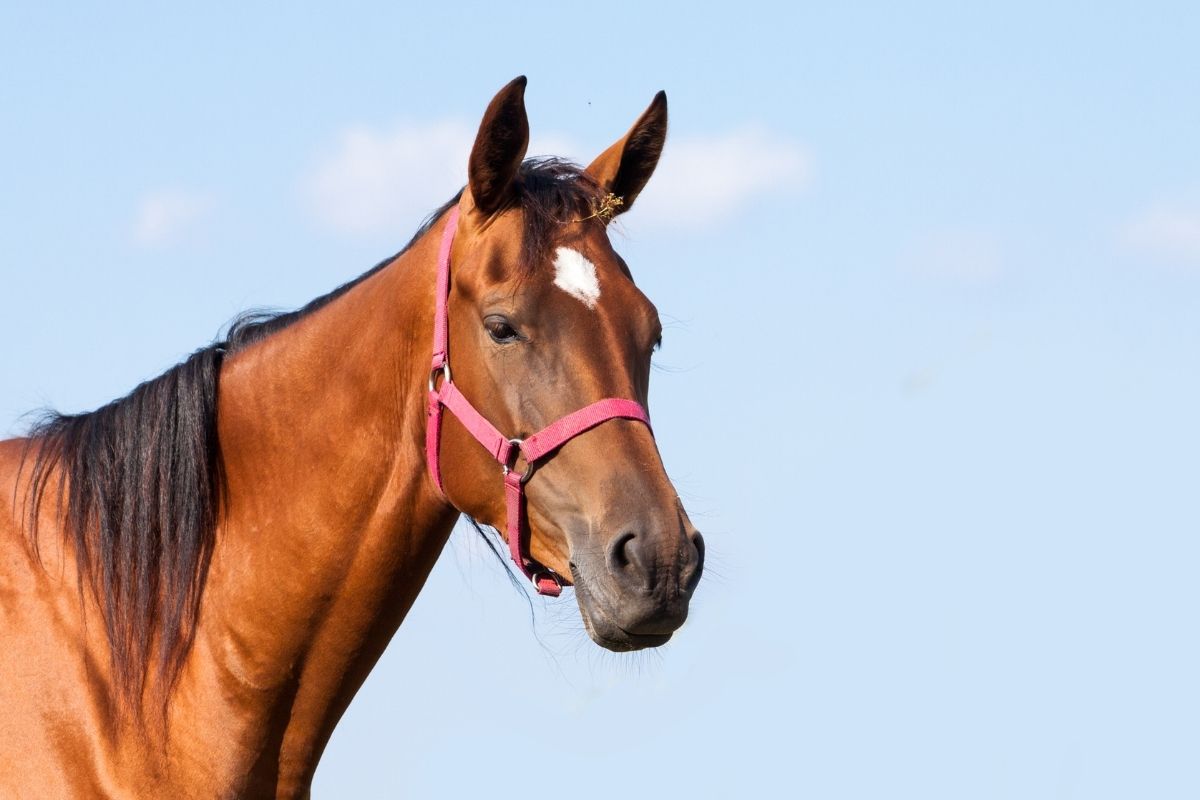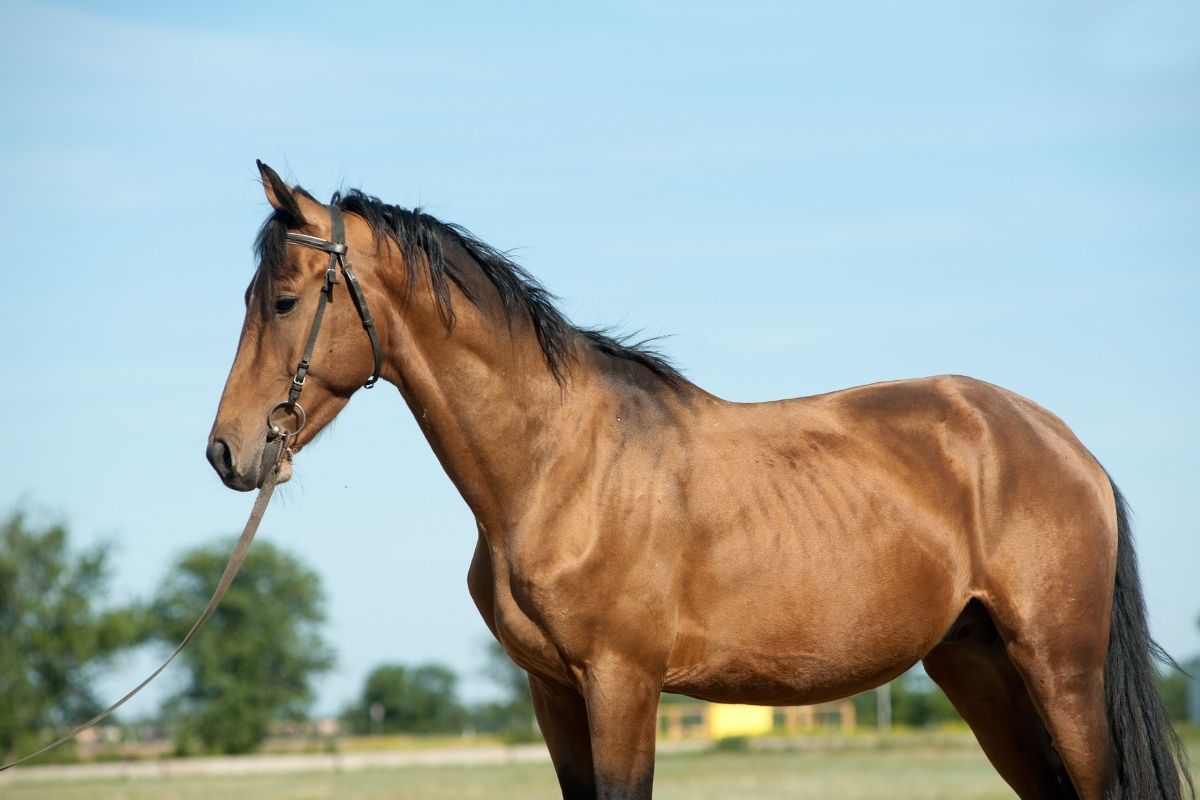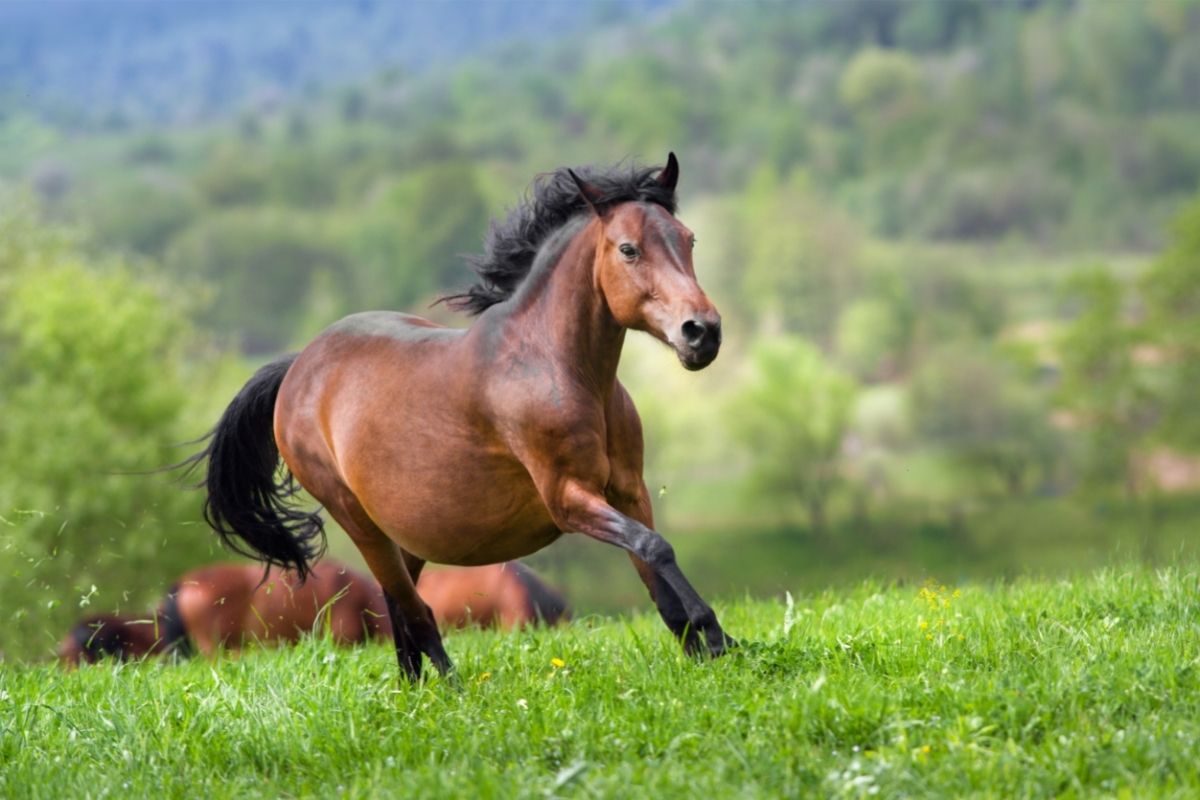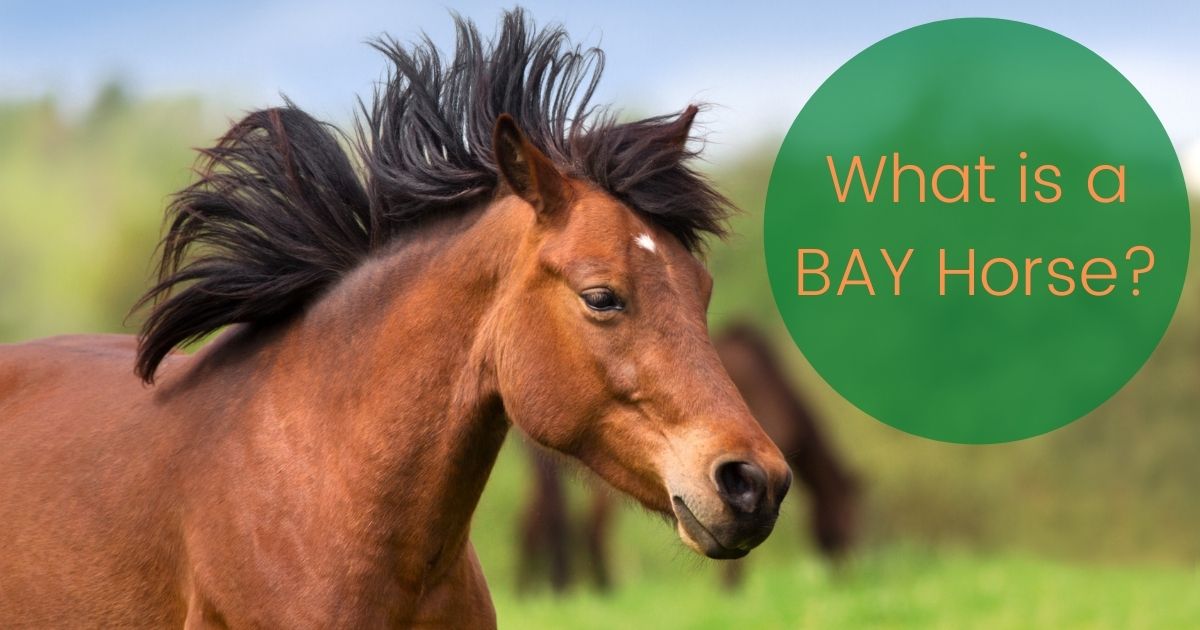What Color is a Bay Horse?
The term “bay” is usually used to describe a specific horse coat color. You might be wondering, “what is a bay horse?”. Well, before looking at what it is, it is good to address the issue of its color. Bay coloring is characterized by a reddish-brown coat with black points usually found at the lower legs, ear tips, tail, and mane.
Bay horses come in a variety of colors, from light brown to black. However, for a horse to be officially classified as a bay horse, it must have a black base color and the Agouti gene that transforms coat coloring.
Bay horses are, in fact, complicated. Many equestrians presuppose the term bay only applies to one particular coat coloring. However, their assumption is not correct. Many variations fall in the bay coloring category. As a result, it is essential to educate yourself on the factors that truly define a bay horse.
This piece delves into the complexities of what qualifies a horse as a bay horse. You will also discover some fun facts on this unique coloring, including famous bay horses from history. Let’s dig in! Shall we?
What is a Bay Horse?
Not all bay horses look the same. Therefore, it is challenging to truly understand what defines a horse as a bay horse. As mentioned earlier, bay horses are characterized by the reddish-brown coat that includes black points around the mane, ear tips, tail, and lower legs. They also have the Agouti gene that results in the dark or black color base.
Well, you must be thinking this is a straightforward definition, right? Not so fast! Many other complexities establish the bay horse’s unique color variations. For example, even though most bay horses’ coats are darker, their color also ranges from light copper to almost black. Moreover, other horse breeds feature white patterns made more distinctive by the pinkish skin underneath.
Bay horses show up in various horse breeds. But, they are more common in some breeds than in others. Here are the breeds popular for producing the bay horse color:
- Thoroughbred
- Cleveland Bay
- American Quarter Horse
- Oldenburg
- Mustang Horse
- Belgian Warmblood
All the Components That Make a Horse Bay
Equine experts confirm that all horses have two base coat colors, i.e., red or black. The horse’s coat color is created when other genes influence these base genes.
In this regard, for a horse to be considered bay, it must have an “E” Alle gene and an agouti gene. Additionally, there are two types of agouti genes– the dominant “A” and the recessive “a.”
A horse must have at least one “A” gene to have a bay coat. The “A” gene controls the black points on a horse. This gene is responsible for restricting the black points on the horse’s legs, tail, and mane. It is dominant over the black gene “E.”
Moreover, some bay horses have two copies of “A” or an “A” and an “a.” Therefore, a horse that gets two “a” copies from its parents will be black and not bay.
In short, a bay horse will have one of the following genetic makeups:
- EE/AA
- EE/Aa
- Ee/Aa
- Ee/AA
If you think that is complicated, then the red bay horse gene is even more complicated, i.e., ABCee.
One interesting fact about horse coat color genetics is that the chestnut horse cannot have black points. This is so because its base color is red. Therefore, even if a horse gets an “A” gene from one of its parents, it will not have black points.
You see, the “A” agouti only influences black hair. Therefore, if there is no black hair to transform, the gene becomes redundant.
What about wild coat markings? These are patterns that are usually associated with primitive horses. They come in the form of black markings such as a dorsal stripe and leg strips. You will most likely see these patterns on dun horses.
A dorsal stripe is a dark stripe that runs over the spine from withers to the head of the tail. The primitive markings typically provide a disguise that helps the horse blend in with its environment to make it challenging for predators to spot it.
The “A” agouti gene also controls these markings. Additionally, the “B” and “C” genes also affect the patterns. On the other hand, Essential “A” is a wild pattern gene that influences bay horses. The “A” gene that bay horses carry has evolved.
In this regard, the bay horses don’t express the wild pattern, but the agouti still restricts black to certain parts of its body. The primitive patterns have been inherited from prehistoric wild horses.
However, some horses cannot produce bay, which is down to their genetics. For example, it would be impossible to get a bay foal if you breed a chestnut sire and dam. Why is it so?
Two chestnuts can only produce a chestnut horse color because they pass on “ee” and a red base color to their offspring. However, if you breed a chestnut to a bay horse, it can produce a bay, black, or chestnut. This will only occur if the two horses have a black horse in their family tree. On the other hand, breeding a bay to a gray would result in either color in the ensuing foal.

The Different Shades of Bay Coat Colors
As established earlier, bay horses come in different shades. All the shades fall into a sub-category that has a unique name. The different shades of bay coat colors include:
Blood Bay
The blood bay horse is not very common. It is mainly mistaken for the standard bay. Nevertheless, with some understanding, you can tell that the blood bay horse is reasonably distinctive.
So, how will you distinguish the blood bay from the standard bay? It gets its name from its color, which is full of red tones. It is nearly like a reasonably dark chestnut. Sometimes, the red tint blended with brown can result in a blood bay a purple sheen.
The equine community generally agrees that blood bay is one of the most fine-looking coat colors. However, all bay horses come with black points, meaning a bay horse has a black mane and tail. It also has black on the legs. The blood bay has very distinctive black points, making it even more attractive.
Standard Bay
Just as its name implies, the standard bay is the most common shade of bay. Some people refer to it as the classic bay. Its coat is usually a medium shade that is lighter than a dark bay. Moreover, it has a less deep red than the blood bay.
Its hair is a blend of red tones and brown. It also has black points, with the main coat having the same shade without variations.
Dark Bay
The dark bay shade is the second most common bay coat type. These horses come in very dark coats that appear black. It also has black points; however, it is hard to differentiate them from the body coat color.
You are likely to come across different shades of dark gray. This means you might have to take a closer look for you to tell the difference between dark and black. For example, suppose the horse has red tints and lighter hairs on its body, then it is a bay horse. You will mostly see these features around the muzzle and eyes.
Additionally, you can tell whether the horse is bay by pushing the hair up and taking a closer look at the skin, and you will notice the shade changes from summer to winter. During the winter, the coat appears darker because the hair is longer, making the red tone more hidden.
In this regard, when you body clip a dark bay horse during the winter, it will appear lighter. The dark bay horse’s coat will darken as its hair grows. It is also common for dark bay horses to have dapples. This is mainly because they usually have two-toned hair.
The dapples appear in the form of lighter brown shaded rings on the body. These features are mainly found on the back, upper sides, and haunches. Dapples could be genetic or a sign that the horse is healthy.
Bay Roan
The bay roan is among the rarer colors you will encounter. Horses having this color have been influenced by the roaning gene. The base coat is bay in these horses, but they also have a dominant roan gene.
Additionally, the bay roan comes with black points similar to other bay horses. On the other hand, if it is a red roan, it will have reddish points instead of black. Interestingly, when a bay roan or any shade of roan gets a cut, the hair that grows back is black.
It is not so for a regular bay, chestnut, or black horse. This is because when their hair gets damaged, it grows back in white.
Copper Bay
It is easy to confuse a copper bay with a blood bay. But, there are apparent differences between the two when you take a closer look. For instance, a copper bay is usually lighter than a blood bay.
Moreover, the copper bay horse also has a high concentration of red tones. However, it is not as deep as that of the blood bay. The copper bay usually has a more orange, rust color instead of a near mahogany shade.
Sandy Bay
Sandy bay is another exciting color that you will rarely come across. As a matter of fact, you would have to take a closer look to discover it is a bay, as you might think it is a buckskin horse at first glance.
The sandy bay horse also has black points on its legs and a black tail and mane. They also have a lot of dappling. However, what makes this shade of bay unique is its coat color genetics that the horse possesses.
The horse’s color is light, with a nearly yellowish tone. This is because the horse does not have the bay gene only. It also has a dilution gene– the crème gene, to be specific. It is the crème gene dilutes the coat, making it significantly light.
Bay Dun
The bay dun is similar to the sandy bay in that you can easily confuse it with a genuine dun. However, the bay dun has a bay gene and a dun gene. Furthermore, the bay dun will sometimes exhibit some features that differentiate a bay dun and a dun.
Some of the distinctive features include a dark dorsal stripe and leg stripes. Moreover, its coat is usually duller than a genuine dun and comes in different shades of tan and yellow.
Champagne Bay Horses
Champagne bay is a gorgeous uncommon coat color. A horse must have a black base and the champagne modifier gene to get this color. There are also different types of the champagne bay horse color. The other shade is the outcome of a horse having a red base.
Wild Bay
A wild bay is a light shade that nearly looks like the chestnut. What makes this bay coat type unique is its black points. For example, the black points usually reach up to the knees and hocks on the other bay horses.
However, the black points only reach the fetlock on the wild bay. The wild bay also has a somewhat different agouti gene – the “A+.”.
Brown Horses
Technically speaking, there is no official brown color for horses. But it is easy to make this assumption by simply looking at the horses. Whenever you see a brown horse, it could either be a shade of chestnut or bay, particularly a liver chestnut.
Perlinos
Perlinos are double diluted crème bay horses. This means that they have two crème genes, unlike the sandy bay, which only has one crème gene. Additionally, the double dilution results in the horse’s coat becoming very light crème and sometimes almost white.
Perlinos are very similar to people with albinism in that they have pinkish skin and blue eyes. It also has points coloring like those of a Buckspin. But, on the Perlino, the points are orangish.
The Perlino has been disfavored for several years. In fact, the American Quarter Horse Association did not accept the registration of perlino bay foals. This move by the association did not consider whether both parents were registered quarter horses. However, it left this practice in the 2000s, and now you can register your perlino horse with the AQHA.
How To Know if You Have a Bay Horse
So, how would you know that your horse is a bay horse? Well, this piece has already comprehensively covered the genetic composition of bay horses. However, here is how to tell if your horse is bay:
As mentioned earlier, bay horses have a unique genetic combination. Fortunately, you don’t have to perform a genetic test to know if your horse has the bay genetics as they manifest physically. All bay horses mainly have two base colors, i.e., chestnut and black, from which their bay color is derived. However, some equine experts consider bay as the base color.
In this regard, a bay horse will have these characteristics:
- Their ears have black edges.
- The lower legs are black.
- The mane is also black.
- Bay horses also have black tails.
These are what this article has called black points. Moreover, it is these black points that define a bay horse. This means that you cannot consider your horse as bay if it does not have black points.
Moreover, suppose your bay horse has white markings over its black points; don’t panic. These white points do not make your horse a lesser bay horse. On the contrary, your horse’s black points are as legit as those on other bay horses.
What about the coat? You can also tell your horse is bay by examining its coat. Here are the primary characteristics of a bay horse’s coat:
- A bay horse’s coat carries vibrant pigmentation regardless of its shade. If you care for your horse well and groom it regularly, these pigments will appear vibrant in the sun.
- Additionally, bay horses have dappling. These are irregular markings in the form of irregular spots arranged in concentric circles that don’t match the rest of the coat on the face.
- A bay horse’s hair appears lighter than when you shave it down. This feature is thanks to its two-toned shaft.
It is important to note that these traits vary depending on how you groom your horse. Therefore, others can also use them to indicate how well you care for your horse.

Interesting Facts About Bay Horses
Bay horses have many unique attributes, meaning there are many fun facts about them. Here are the most exciting facts about bay horses:
Some Bay Horses Bear a Resemblance to Black Horses
Bay horses’ colors range from light to dark, making it more challenging to distinguish a real bay horse. In this regard, some bay horses are almost identical to black horses. The primary method you can use to differentiate between a dark bay horse and a true black horse is to look for the reddish-brown hairs which appear around the muzzle, eyes, and elbow of a bay horse.
Some Bay Horses Have a Dark Stripe Down the Back
Some bay horses have a dun gene, which influences their coloring. The bay horses that possess this gene are referred to as bay duns. Moreover, they have a dark stripe down their back. Also, the bay duns are often referred to as Zebra duns because of the stripe’s location and coloring.
Some Bay Horses Come with Two-Toned Hair
When you clip some bay horses, they seem to have two-toned hair. On some occasions, the bay horse’s hair shaft appears significantly lighter at the base than at the top of the hair shaft. However, the two-toned coloring disappears when the horse’s hair grows again.
Some Bay Horses Look, Albino
The perlino is one of the unique bay horse types. However, it is not like the sandy bay, which has one crème gene. Instead, the perilino has a double diluted crème gene. This results in a pinkish skin tone, blue eyes, and orange points instead of the standard black points.
Famous Bay Racing Horses
When you look at the history of famous horses, you will discover that many of the legendary horses are bay. Here are the most notable racehorses:
Seabiscuit– Light Bay
Seabiscuit is arguably the most common bay horse of all time. It is a light bay horse that made its name in the late 9130s for beating War Admiral, a triple crown winner. Apart from this momentous achievement, Seabiscuit also boasts of being the Horse of the Year in 1938.
Northern Dancer– Standard Bay
Northern Dancer made history in the equine industry when the standard bay won the Preakness and Kentucky Derby. However, Northern Dancer was also celebrated as one of the most successful sires in the 20th century.
Cigar– Dark Bay
Cigar made his name as the world’s leading money earner. Additionally, he was named the Horse of the Year twice in 1995 and 1996.
Big Brown– Standard Bay
Big Brown made his name in 2008 when he won the Kentucky Derby and Preakness. Apart from that, he was also recognized as the three-year-old champion colt back in 2008. The only time he tasted defeat was in the Belmont Stakes in 2008.
American Pharaoh– Standard Bay
The American Pharaoh is regarded as one of the most famous living racehorses. He is an outstanding Thoroughbred stallion that won the Triple Crown in 2015. Moreover, the American Pharaoh is regarded as a standard bay despite his coat having a lot of red.
Zenyatta– Dark Bay
Zenyatta is a female horse famous for being one of the most successful fillies ever. One of her notable achievements was being the first mare to win the Breeders’ Cup Classic. What’s more, she outran the colts on her way to making history.
Big Star– Standard Bay
Big Star is the bay stallion famous for taking home the individual gold medal at the Rio Olympic Games in 2012. He is now a retired stallion used for breeding. Big Star is a show-jumping legend.

Summary
Despite their unique coat color, bay horses remain some of the most stunning horses. Their colors range from light to dark but what distinguishes them is their black points which decorate their ear tips, lower legs, tails, and manes.
Even though the only proper way to determine whether a horse is a bay is genetic testing, their inimitable markings make it effortless to distinguish them from other horse coat coloring.
Fortunately, if you have read this piece to this end, you are well-equipped with bay coloring knowledge. This means you can effortlessly identify bay horses. So, do you have a bay-colored horse in your string?
